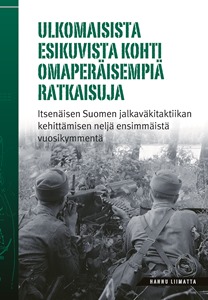Dissertation on the history of infantry tactics development
Colonel (retired) Hannu Liimatta’s dissertation in the field of military history titled Ulkomaisista esikuvista kohti omaperäisempiä ratkaisuja – Itsenäisen Suomen jalkaväkitaktiikan kehittämisen neljä ensimmäistä vuosikymmentä (From foreign models to individual solutions – the first forty years of infantry tactics development in an independent Finland will be held in the National Defence University in Santahamina on 22 October 2018 at 12.00.

The dissertation looks at how the central factors influencing infantry tactics, the manuals, the wartime unit compositions, kit and training were developed during the time period from Finland declaring her independence until the mid-1950s.
The official opponent at the dissertation will be Colonel Petteri Jouko from the Finnish Ministry of Defence. The custos will be Professor, Major General (ret.) Vesa Tynkkynen, from the National Defence University.
According to the dissertation the goal of developing this military theory and art was to create such methods that enabled an outnumbered defender to hold its own in combat against a materially and numerically superior enemy. The goal of developing infantry tactics was uniquely Finnish tactics. It meant applying the military theoretical principles to the Finnish conditions. It was seen that successful tactics required the infantry to have particularly firepower and mobility.
In the early years of Finnish independence models for developing tactics were sought from abroad until domestic officer training started to produce facility for more original tactical thinking. In the decades preceding the Winter War (1939-1940) the infantry became skilled particularly in small unit combat. This was seen both during the demanding winter and woodland battles of the Winter War and the attack during the attack phase of the early Continuation War (1941-1944).
During the trench warfare phase of the Continuation War there was no systematic development in infantry tactics. The problems leading to the regression of those tactics were mainly because, unlike other branches, the infantry did not have a branch director in the wartime General Headquarters who would have shouldered the responsibility of developing infantry tactics during the war. The responsibility for said development was spread out to many instances and the entirety might not have been under the control of the General Headquarters.
The first decade after World War II was also an era of shortages in terms of infantry tactics development. The experiences gained from the war had been written down in the manuals, but the challenge quickly became obsolete war materiel and kit, and most of all, new threats. In order to respond to those threats, the thought of a regional defence system was born and this also meant a move to more original tactical thinking.
Further information
Colonel (G.S, ret) Hannu Liimatta (b. 1957) has, among other duties, served as the Commanding Officer of Kymi Jaeger Battalion , Guard Jaeger Regiment, as the Deputy Chief of the Training Division at Defence Command Finland and as the Director of the Post-Graduate Division in the National Defence University.
The dissertation will be held at the National Defence University’s Santahamina Building, Auditorium Itälinnake. Information on confirming participation and arriving at the function can be found at: lyyti.in/Liimatta.
The dissertation publication will be available online at the Doria publication archive at least 10 days before the dissertation.
Doctoral candidate’s contact information:
Hannu Liimatta
[email protected]
tel. +358408320684



